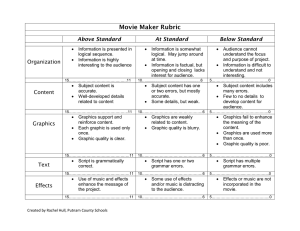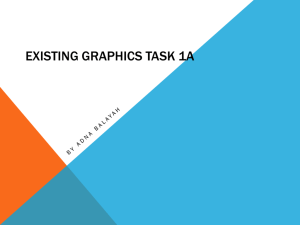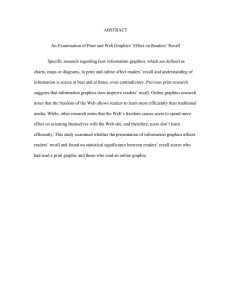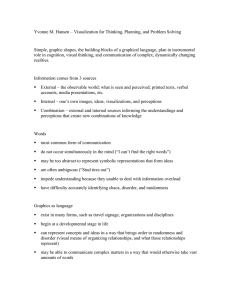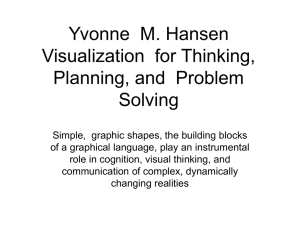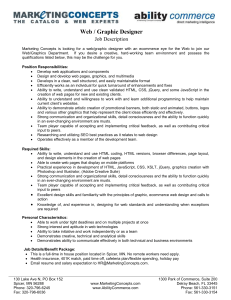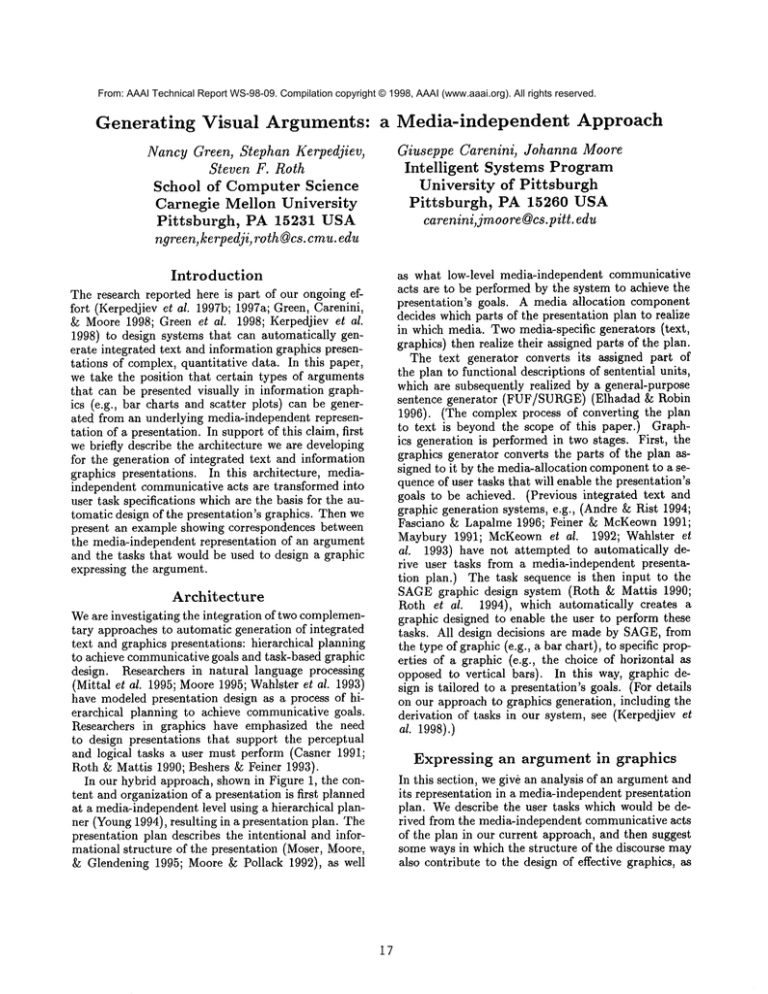
From: AAAI Technical Report WS-98-09. Compilation copyright © 1998, AAAI (www.aaai.org). All rights reserved.
Generating
Visual
Arguments:
a Media-independent
Approach
Giuseppe Carenini, Johanna Moore
Intelligent
Systems Program
University of Pittsburgh
Pittsburgh,
PA 15260 USA
carenini,jmoore@cs.pitt, edu
Nancy Green, Stephan Kerpedjiev,
Steven F. Roth
School
of Computer
Science
Carnegie
Mellon
University
Pittsburgh,
PA 15231
USA
ngreen, kerpedji, roth @cs. cm u. edu
Introduction
as what low-level media-independent communicative
acts are to be performed by the system to achieve the
presentation’s goals. A media allocation component
decides which parts of the presentation plan to realize
in which media. Twomedia-specific generators (text,
graphics) then realize their assigned parts of the plan.
The text generator converts its assigned part of
the plan to functional descriptions of sentential units,
which are subsequently realized by a general-purpose
sentence generator (FUF/SURGE)(Elhadad ~ Robin
1996). (The complex process of converting the plan
to text is beyond the scope of this paper.) Graphics generation is performed in two stages. First, the
graphics generator converts the parts of the plan assigned to it by the media-allocation componentto a sequence of user tasks that will enable the presentation’s
goals to be achieved. (Previous integrated text and
graphic generation systems, e.g., (Andre & Rist 1994;
Fasciano & Lapalme 1996; Feiner ~ McKeown1991;
Maybury 1991; McKeownet al. 1992; Wahlster et
al. 1993) have not attempted to automatically derive user tasks from a media-independent presentation plan.) The task sequence is then input to the
SAGEgraphic design system (Roth & Mattis 1990;
Roth et al. 1994), which automatically creates
graphic designed to enable the user to perform these
tasks. All design decisions are made by SAGE,from
the type of graphic (e.g., a bar chart), to specific properties of a graphic (e.g., the choice of horizontal as
opposed to vertical bars). In this way, graphic design is tailored to a presentation’s goals. (For details
on our approach to graphics generation, including the
derivation of tasks in our system, see (Kerpedjiev et
al. 1998).)
The research reported here is part of our ongoing effort (Kerpedjiev et al. 1997b; 1997a; Green, Carenini,
g5 Moore 1998; Green et al. 1998; Kerpedjiev et al.
1998) to design systems that can automatically generate integrated text and information graphics presentations of complex, quantitative data. In this paper,
we take the position that certain types of arguments
that can be presented visually in information graphics (e.g., bar charts and scatter plots) can be generated from an underlying media-independent representation of a presentation. In support of this claim, first
we briefly describe the architecture we are developing
for the generation of integrated text and information
graphics presentations. In this architecture, mediaindependent communicative acts are transformed into
user task specifications which are the basis for the automatic design of the presentation’s graphics. Then we
present an example showing correspondences between
the media-independent representation of an argument
and the tasks that would be used to design a graphic
expressing the argument.
Architecture
Weare investigating the integration of two complementary approaches to automatic generation of integrated
text and graphics presentations: hierarchical planning
to achieve communicative goals and task-based graphic
design. Researchers in natural language processing
(Mittal et al. 1995; Moore1995; Wahlster et al. 1993)
have modeled presentation design as a process of hierarchical planning to achieve communicative goals.
Researchers in graphics have emphasized the need
to design presentations that support the perceptual
and logical tasks a user must perform (Casner 1991;
Roth & Mattis 1990; Beshers & Feiner 1993).
In our hybrid approach, shownin Figure 1, the content and organization of a presentation is first planned
at a media-independent level using a hierarchical planner (Young1994), resulting in a presentation plan. The
presentation plan describes the intentional and informational structure of the presentation (Moser, Moore,
&~ Glendening 1995; Moore & Pollack 1992), as well
Expressing
an argument
in
graphics
In this section, we give an analysis of an argumentand
its representation in a media-independent presentation
plan. Wedescribe the user tasks which would be derived from the media-independent communicative acts
of the plan in our current approach, and then suggest
some ways in which the structure of the discourse may
also contribute to the design of effective graphics, as
17
Cornrnunicative
I
Media-Independent
Discourse
Operators
]
=_1
Goal
Planner
1~_~
Media-independent
Text
Text
Media Allocation/
Coordination
Microplanner
1
Plan
Graphics
Generator
Text Realizer
(FUF/SURGE)
Database
Graphics
Generator
Microplanner
[
Graphics
Designer
(SAGE)
]
Presentation
Figure 1: Integrated Text-Graphics GenerationArchitecture
well as its influenceon mediaallocation.
Analysis
of example
The goal of the examplepresentationI is for the user
to accept the belief that a certain local newspaper,
the Post-Gasette (PPG), has more readers than the
total numberof readers of all other newspapersthat
are subscribedto in someregion. Theuser is currently
ignorant of this fact, but probablywouldnot accept it
just on the basis of a simple assertion by the system,
due to his current beliefs. In particular, the user knows
that the NewYork Times (NYT)has more readers
than the Wall Street Journal (WSJ)in the region, and
erroneouslybelieves that becauseof this, the NewYork
Timesmust have the largest numberof readers of all
newspapersin the region. However,the latter belief is
incompatiblewith the belief whichit is the goal of the
presentation to get the user to accept.
To simplify discussion, let us abbreviate the propositions playinga role in the exampleas follows:
* Q: the numberof readers of NYTexceeds the number of readers of WSJ
¯ It: the numberof readers of NYTexceeds the number of readers of any other paper in the region
¯ T: the numberof readers of PPGexceeds the total
numberof readers of all other papers in the region.
An argumentstrategy for this situation can be defined as follows. If the stated constraints hold, andthe
stated subgoals are achieved, then the stated goal will
be achieved:
1 Thedata usedin this example
is fictitious.
18
¯ Goal: (BMB
User T), i.e., the goal is that the User
believe that it is mutuallybelieved with the system
2that T,
¯ Constraints:
- (Bel System (Bel User Q)), the system
lieves that the user believes that Q,
- (Bel System (Bel User (Entails Q R))),
system believes that the user believes that Q entails R.
- (Bel System (Incompatible R T)), the system
believes that R and T cannot both be true,
- (Bel System Q), the system believes that
- (Bel SystemT), the system believes that T, and
- (Bel System(not It)), the system believes
R is false,
¯ Subgoals:
- (BMBUser Q), i.e., make sure that the User
knowsthat the Systemis aware of Q,
- (BMBUser (not (Entails Q R)))
- (BMB User (Bel System T))
One wayin whicheach of the above three subgoals
could be achievedis by the followingactions:
¯ (Acknowledge System User Q), which achieves
(BMB User Q).
¯ (Assert System User (not R)), which achieves
(BMBUser (not (Entails Q It))) provided
(BMB User Q).
2BMB
is a one-sided mutualbelief operator (Clark
Marshall1981);(BMBagentproposition)is interpreted as
agentbelievesit to be mutuallybelievedwiththe otheragent
that propositionholds.
Convincement
Post-Gazette
ser T)
Concession
Total others
(Assert Sys User (not R))
NYT
(Acknowledge Sys User Q)
Number
of readers
Figure 2: Discourse Plan
Figure 3: Graphic realizing the argument
¯ (Assert System User T), which achieves (BMB
User (Bel System T)).
In summary,the intentional structure of this argument can be represented in the plan shownin Figure 2.
(The figure shows only the hierarchical relations among
the communicative acts and the core-contributor distinction amongacts; unlabelled acts are contributors.)
Such a plan might be realized in text as follows: Although the New York Times is read by more people in
Western PA than the Wall Street Journal, the New
York Times does not have the highest number of readers in the region. The Post-Gazette has more readers
than the total numberof readers of all other newspapers
in the five-county Western PA region.
Realization
in Graphics
A graphic realizing this argument is shown in Figure 3. The core of the argument, the assertion that T
holds, is expressed by enabling the user to perform the
task of comparingthe upper bar’s length (which represents the number of readers of PPG) to the lower bar’s
length (which represents the total numberof readers of
the other newspapers). (In general, an assertion that
some quantity is greater than another quantity would
be transformed by our graphics generator into a comparison task; for details on the process of deriving a
task sequence, see (Kerpedjiev et al. 1998).)
The contributor given in support of T is expressed in
the same graphic, although less prominently. Its core
consists of the assertion (not R), which is expressed
the graphic indirectly by falsifying R. That is, by enabling the user to perform the task of comparing the
length of the segment of the lower bar labelled NYT
to the length of the upper bar, the user can see that
there is one newspaper (PPG) with more readers than
NYT,which falsifies R. The concession Q (contributing to the acceptance of the assertion that R does not
hold), is expressed within the lower bar by enabling
the user to perform the task of comparing the length
of the segment labelled NYT(representing the number
of NYTreaders) to the length of the segment labelled
WSJ(representing the number of WSJreaders).
19
Thus, in our current approach each the three lowlevel communicative acts of this plan would be transformed into the comparison tasks described above. The
tasks would then be used by SAGEto design a graphic
such as the one shown in Figure 3 to support these
tasks. Note that more than one graphic may be designed by SAGEto support the tasks. An interesting open question that we are investigating is howthe
intentional structure of an argument should influence
graphic design. In this graphic, for example, the assertion corresponding to the core of the argument is
more visually prominent than the other information
since the graphic contains only two horizontal bars, one
for each of the entities comparedin the core assertion.
Also, the quantities comparedin the core assertion are
encoded differently (i.e. as horizontal bars) from the
other quantities (i.e. as segments of a stacked bar).
The user mayinterpret the difference as conversationally implicating an important distinction in the two
sets of quantities (Marks & Reiter 1990).
A related issue is the role of discourse structure in
media allocation. For example, if the graphic shownin
Figure 3 is accompaniedonly by text realizing the core
of the argument (e.g., The Post-Gazette has more readers than the total numberof readers of all other newspapers in the five-county Western PA region), then the
text would contribute to the user’s recognition of the
main point of the graphic. On the other hand, if the
same graphic is accompaniedonly by text realizing one
of the other acts of the plan (e.g., The NewYork Times
has more readers than the Wall Street Journal), then
the text might impede the user’s recognition of the
main point of the graphic. In future work, we hope to
address these open issues.
Acknowledgments
This project was supported by DARPA,contract DAA1593K0005.
References
Ninth National Conference on Artificial Intelligence,
61-66.
McKeown,K.; Feiner, S.; Robin, J.; Seligmann, D.;
and Tanenblatt, M. 1992. Generating cross-references
for multimedia explanation. In Proceedings of AAAI,
9-16.
MittM, V.; Roth, S.; Moore, J.; Mattis, J.; and
Carenini, G. 1995. Generating explanatory captions
for information graphics. In Proceedings, 1276-1283.
Montreal: International Joint Conference on Artificial Intelligence.
Moore, J. D., and Pollack, M. E. 1992. A problem
for RST: The need for multi-level discourse analysis.
Computational Linguistics 18(4):537-544.
Moore, J. D. 1995. Participating in Explanatory Dialogues. MITPress.
Moser, M.; Moore, J. D.; and Glendening, E. 1995.
Instructions for coding explanations: Identifying segments, relations and minimal units. Technical report,
Learning Research and Development Center, University of Pittsburgh, Pittsburgh, Pennsylvania.
Roth, S., and Mattis, J. 1990. Data characterization
for intelligent graphics presentation. In Proceedings
of the Conference on Human Factors in Computing
Systems (SIGCHI ’90), 193-200.
Roth, S. F.; Kolojejchick, J.; Mattis, J.; and Goldstein, J. 1994. Interactive graphic design using automatic presentation knowledge. In Proceedings of the
Conference on HumanFactors in Computing Systems
(SIGCHI ’9~), 112-117.
Wahlster, W.; Andre, E.; Finkler, W.; Profitlich, H.J.; and Rist, T. 1993. Plan-based integration of natural language and graphics generation. Artificial Intelligence 63:387-427.
Young, M. R. 1994. A developer’s guide to the longbow discourse planning system. Technical Report ISP
TR Number: 94-4, University of Pittsburgh, Intelligent Systems Program.
Andre, E., and Rist, T. 1994. Referring to world objects with text and pictures. In Proceedings of COLING, 530-34.
Beshers, C., and Feiner, S. 1993. AutoVisual: Rulebased design of interactive multivariate visualization.
IEEE Computer Graphics and Applications 41-49.
Casner, S. M. 1991. A task-analytic
approach to
the automated design of information graphic presentations. ACMTransactions on Graphics 10(2):111151.
Clark, H., and Marshall, C. 1981. Definite reference
and mutual knowledge. In Joshi, A. K.; Webber, B.;
and Sag, I., eds., Elements of discourse understanding. Cambridge: Cambridge University Press.
Elhadad, M., and Robin, J. 1996. An overview of
SURGE:A reusable comprehensive syntantic reMiz~tion component. Technical Report Technical Report
96-03, Dept of Mathematics and Computer Science,
Ben Gurion University, Beer Sheva, Israel.
Fasciano, M., and Lapalme, G. 1996. PostGraphe: a
System for the Generation of Statistical Graphics and
Text. In Proceedings of the 8th International Natural
Language Generation Workshop, 51-60.
Feiner, S., and McKeown,K. 1991. Automating the
generation of coordinated multimedia explanations.
IEEE Computer 24(10):33-40.
Green, N.; Carenini, G.; Kerpedjiev, S.; Roth, S.;
and Moore, J. 1998. A media-independent content
language for integrated text and graphics generation.
Submitted.
Green, N.; Carenini, G.; and Moore, J. 1998. Generating attributive descriptions for integrated text and
information graphics presentations. In Proceedings of
the Ninth International Workshop on Natural Language Generation. To appear.
Kerpedjiev, S.; Carenini, G.; Roth, S.; and Moore, J.
1997a. AutoBrief: a multimedia presentation system
for assisting data analysis. Computer Standards and
Interfaces 18:583-593.
Kerpedjiev, S.; Carenini, G.; Roth, S. F.; and Moore,
J.D. 1997b. Integrating
planning and task-based
design for multimedia presentation. In International
Conference on Intelligent User Interfaces (IUI ’97),
145-152. Association for Computing Machinery.
Kerpedjiev, S.; Carenini, G.; Green, N.; Roth, S. F.;
and Moore, J. D. 1998. Saying it in graphics: from
intentions to visualizations. Submitted.
Marks, J., and Reiter, E. 1990. Avoiding unwanted
conversational implicatures in text and graphics. In
Proceedings of the National Conference on Artificial
Intelligence, 450-455.
Maybury, M. T. 1991. Planning multimedia explanations using communicativeacts. In Proceedings of the
2O

